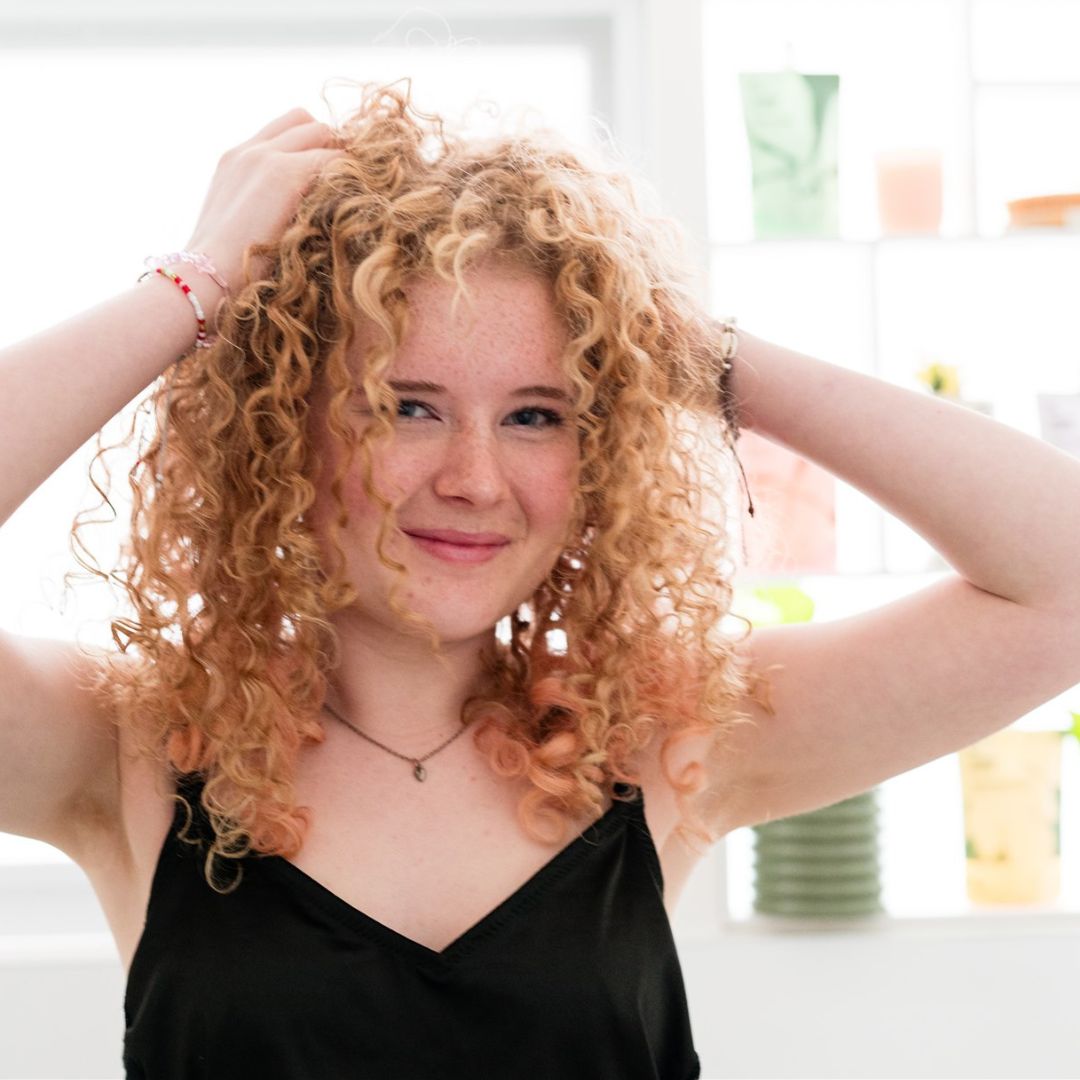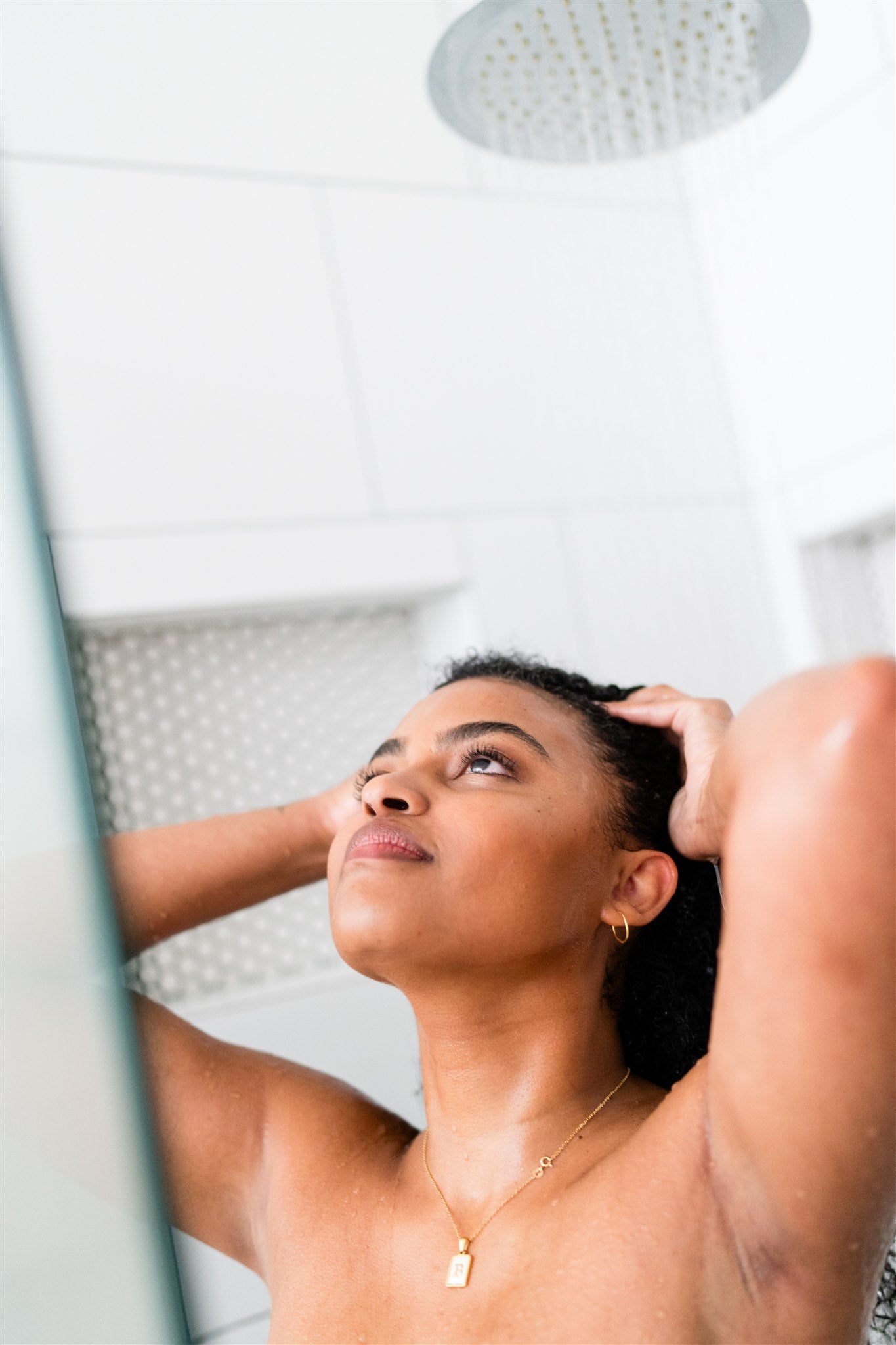What does porosity mean?
Porosity is a measurement of the hair’s ability to absorb and hold moisture. It can also be described as the indicator of how easily moisture can penetrate the hair. Hair porosity is largely determined by genetics, but can also be altered by external factors such as heat and chemical processing.
Depending on how porous the hair is, it may be classified as having high, medium, or low porosity. There are several factors that can permanently affect your hair’s porosity, some more drastically than others:- Excessive exposure to the sun, UVA and UVB rays
- Air pollution
- Dying your hair
- Frequent use of heat styling (flat irons, hair curlers etc.)
- Bleaching your hair
Hair porosity test
1. Fill a clear glass or bowl with water.

2. Place a strand of your hair in the water.

3. Watch to see how quickly it sinks to the bottom.

Results
- High porosity hair will sink to the bottom quickly.
- Medium porosity hair will likely float in the middle of the glass for a while before sinking to the bottom.
- Low porosity hair will float at the top for some time before slowly sinking.
Low Porosity
The characteristics of low porosity hair
Low porosity means the structure of your hair doesn’t easily allow moisture to be absorbed into the hair shaft. Hair is water-resistant, which means the strands will remain floating towards the surface even after a few minutes. Making it more challenging for water to saturate your hair when it’s washed. Usually, if you have low porosity hair, it’s due to genetic factors. If the cuticles are too close together, it can prevent moisture from being soaked up.
You may have low porosity hair if:
- Hair can also be more challenging to process and style because this type of hair tends to repel moisture - hair products don’t absorb easily and sit on the hair
- Washing and drying can take longer than you’d expect
- Water isn’t easily absorbed, you may find it can be challenging to get your hair wet and for the water to penetrate your hair thoroughly
- It takes a long time for your hair to air dry
Certain ingredients can make low porosity hair easier to care for. Knowing the types of products to use and which ones to avoid can make a difference in the manageability and health of your hair.
Some tips for low porosity hair
TIP 1
Because water isn’t easily absorbed, you may find it can be challenging to get your hair wet and for the water to penetrate your hair thoroughly. Once your hair is wet, it can take a long time to air-dry. Even using a blow dryer may take longer than it does for others who have hair that’s the same length and thickness as yours.
TIP 2
Apply products when your hair is wet and warm. Heat can lift the hair cuticle, allowing oils and moisture to penetrate the hair shaft more easily.
TIP 3
For low porosity hair, you’ll want to stay away from protein treatments/ formulas. Protein formulas can increase the risk of hair breakage since they tend to pull moisture out of the hair.
TIP 4
Your hair needs something that can penetrate its core and hydrate it from the inside. This is where deep conditioning comes in. This type of hair can leave in our Conditioner rather than washing it out - i.e. use as a leave in conditioner!
Medium Porosity
The characteristics of medium porosity hair
With medium or regular porosity hair, the cuticles aren’t too close together but aren’t too open either. This allows moisture to penetrate quickly, making it easier to retain moisture for a more extended period of time. Heat damage and other chemical processes can cause normal porosity hair to change over time.
You may have medium porosity hair if:
- Hair is easy to style and can hold styles for a reasonable length of time
- Hair takes colour well
- Hair tends to look healthy, shiny, or glossy
- It doesn’t take too long for your hair to air dry
Some tips for medium porosity hair
TIP 1
You actually don’t have a lot to do if you have medium porosity or normal porosity hair. Your hair already does a good job of absorbing and retaining moisture, which keeps it healthy and hydrated. If you are looking for the perfect shampoo for your hair to stay clean and nourished, you can use our shampoo. This gentle cleansing shampoo removes the impurities in your hair without stripping your hair’s natural moisture. Follow this up with with our hydrating conditioner.
TIP 2
Before going to bed, remove your towel or t-shirt, and scrunch our hydrating curl gel into your curls. Then, flip curls over and slide a buff (what is a buff you ask - a long, wide tube of stretchy fabric that can be worn over your head to protect your hair) over the hair. Use this to help hold your curls off your face, as well as give the volume to strands overnight. If you don't have a buff, a very loose pineapple or bun can work as well, or you can try a scarf. Make sure to use a silk/satin pillowcase, so not to damage curls. In the morning, remove buff or protective style and gently shake curls out. If your curls are still gel cast, break the cast and add a leave-in conditioner or a refreshing spray as needed to help your curls bounce back into place. Enjoy beautiful overnight curls!
TIP 3
A clarifying wash day is when you use our shampoo for the purpose of removing buildup on your scalp or hair. Doing this once a week or fortnight is ideal.
If you have hard water, opt for a chelating clarifying shampoo. If you aren’t sure if you have hard water, they make water test kits that can tell you if your water is hard. A common sign of hard water is when your faucets, shower head, etc get mineral deposits around them over time. Hard water deposits look whitish with a slightly blue tint. When we had hard water in the past, we had to periodically soak our sink dish sprayer and shower head in vinegar because the hard water deposits would cause our faucet’s water output to be reduced or to come out in an uneven flow.
High Porosity
The characteristics of medium porosity hair
High porosity hair means that hair can easily absorb water, oils, dirt and other types of products. On the flip side, if hair is highly porous, it may not retain that moisture. It can be a genetic reason but can also be caused through chemicals and heat applications like straightening, blow-drying, bleaching, and other chemical applications. These types of treatments can damage your cuticles, causing them to lift or separate. This can create gaps between your cuticles, and, as a result, your hair may be more porous than it would typically be.You may have high porosity hair if:
- Water and other moisturizing products are quickly absorbed into your hair
- Your hair tends to break easily
- Your hair tends to be frizzy and dry
- It doesn’t take much time for your hair to air dry
Some tips for high porosity hair
TIP 1
This hair type likes and needs protein - try our protein treatment!
TIP 2
Hair with high porosity can easily absorb moisture, but retaining it is challenging. Since the cuticles are spaced quite far, you lose moisture easily so you’ll need something that will be absorbed into your hair but continue to keep your hair hydrated. This type of hair can leave in our conditioner rather than washing it out - i.e. use as a leave in conditioner!





